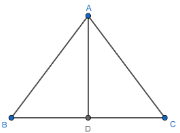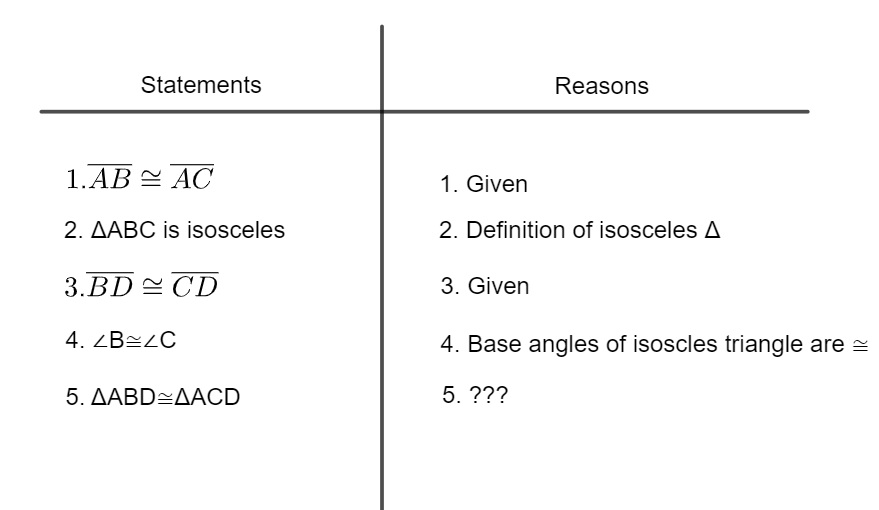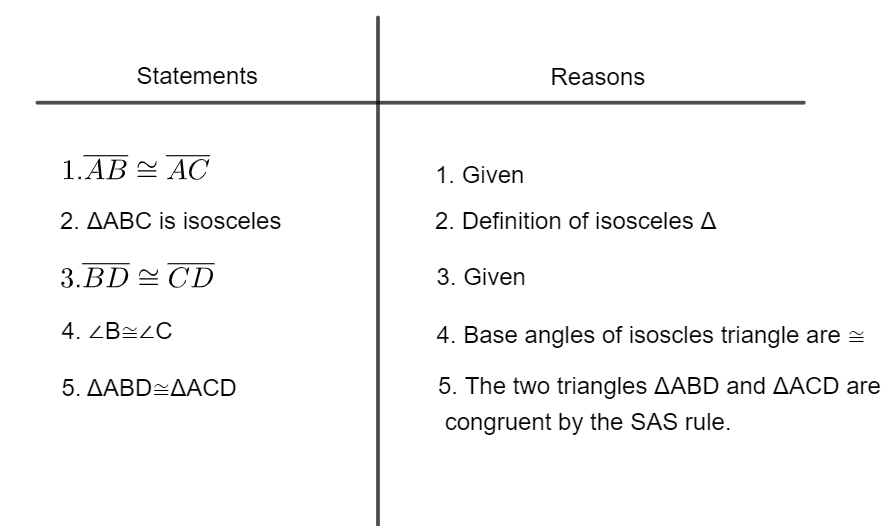
What is the missing reason in the proof?




Answer
510.9k+ views
Hint: We solve this question by using the basic principles of congruence of triangles concept. Here, we are given a certain set of data and using this, we need to fill in the missing reason in the proof. We can see the similarities in the two triangles given. Hence, looking at these similarities, we fill in the blank showing that the given triangles are congruent by one of the rules.
Complete step by step solution:
In order to solve this question, let us consider all the data in the given table. Firstly, it is said that the sides AB and AC of the two adjacent triangles are similar. This means that we have one of their corresponding sides equal.
Now, we consider point 2. According to the definition of isosceles triangle, the given triangle ABC is isosceles since it has two sides of the same length which are sides AB and AC.
Next, according to point 3, it is given that the two sides BD and CD are similar. This means that we have one more corresponding side equal and this corresponding side in this case is the base of the triangle.
According to the 4th point the two angles $\angle B$ and $\angle C$ are similar. The reason for this being that the two base angles of an isosceles triangle are equal. This shows one more condition of the corresponding base angles being equal.
Using these three similarities, we can say that the two triangles are congruent by the SAS rule. The SAS stands for side-angle-side which means that the two corresponding sides and one included angle are equal in both the triangles. Hence, the reason which is missing in the table is that the two triangles are congruent by the SAS rule.
We fill this in the table as follows,

Hence, we have filled in the missing data in the table.
Note:
We need to know the basic concepts of congruence of triangles in order to solve such problems. There are four important criteria to show that two triangles are congruent and they are given by Side-Side-Side, Side-Angle-Side, Angle-Side-Angle, and Angle-Angle-Side. Also, we need to note that Corresponding parts of congruent triangles are the same.
Complete step by step solution:
In order to solve this question, let us consider all the data in the given table. Firstly, it is said that the sides AB and AC of the two adjacent triangles are similar. This means that we have one of their corresponding sides equal.
Now, we consider point 2. According to the definition of isosceles triangle, the given triangle ABC is isosceles since it has two sides of the same length which are sides AB and AC.
Next, according to point 3, it is given that the two sides BD and CD are similar. This means that we have one more corresponding side equal and this corresponding side in this case is the base of the triangle.
According to the 4th point the two angles $\angle B$ and $\angle C$ are similar. The reason for this being that the two base angles of an isosceles triangle are equal. This shows one more condition of the corresponding base angles being equal.
Using these three similarities, we can say that the two triangles are congruent by the SAS rule. The SAS stands for side-angle-side which means that the two corresponding sides and one included angle are equal in both the triangles. Hence, the reason which is missing in the table is that the two triangles are congruent by the SAS rule.
We fill this in the table as follows,

Hence, we have filled in the missing data in the table.
Note:
We need to know the basic concepts of congruence of triangles in order to solve such problems. There are four important criteria to show that two triangles are congruent and they are given by Side-Side-Side, Side-Angle-Side, Angle-Side-Angle, and Angle-Angle-Side. Also, we need to note that Corresponding parts of congruent triangles are the same.
Recently Updated Pages
Master Class 9 Social Science: Engaging Questions & Answers for Success

Master Class 9 Science: Engaging Questions & Answers for Success

Master Class 9 English: Engaging Questions & Answers for Success

Master Class 9 Maths: Engaging Questions & Answers for Success

Master Class 9 General Knowledge: Engaging Questions & Answers for Success

Class 9 Question and Answer - Your Ultimate Solutions Guide

Trending doubts
Which places in India experience sunrise first and class 9 social science CBSE

Fill the blanks with the suitable prepositions 1 The class 9 english CBSE

Write the 6 fundamental rights of India and explain in detail

Difference Between Plant Cell and Animal Cell

What is pollution? How many types of pollution? Define it

What is the Full Form of ISI and RAW




